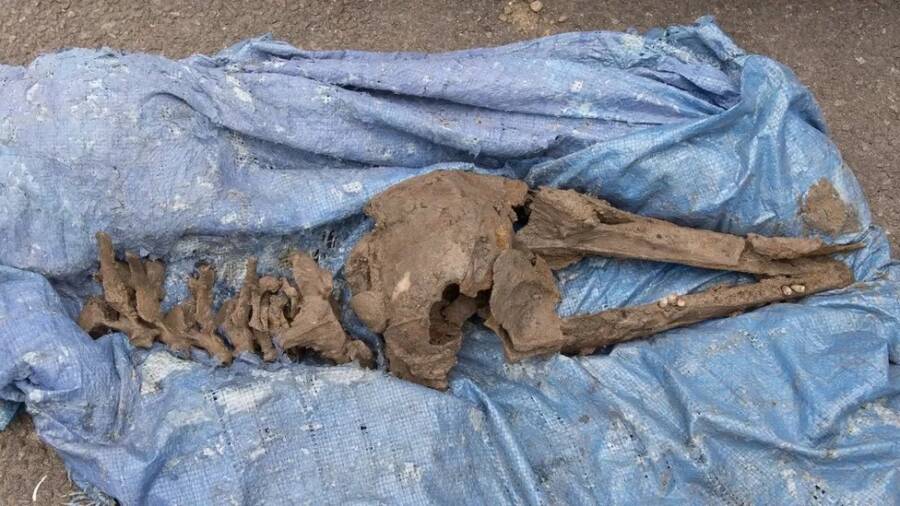The prehistoric skeleton was discovered a few feet beneath the ground, alongside a cutting tool made of deer antler that archaeologists think was used by humanity's ancestors.

Mike Day/Saltire News and Sport Ltd.Paul McDonald posing with the dolphin bones recovered from his backyard.
When 44-year-old Paul McDonald began digging out a swimming pool for his children in his backyard, he didn’t expect to find anything buried there — let alone 8,000-year-old dolphin bones. Yet, that is exactly what he found.
As the BBC reported, the Scottish father of four recognized the dolphin’s skull right away once he struck the bone, due to its unmistakable shape and rows of teeth.
“I was digging away in the swimming pool when I caught something unusual,” McDonald said. “I rolled it back and came down and pulled it out. I saw the roundness of the skull and then saw the snout and teeth, and I knew right away it was a dolphin.”
The dolphin bones were preserved in clay, just about 31 inches below the current ground level. Archaeologists believe they may have been buried there for up to 8,000 years, likely washing up after the last Ice Age, with one calling the discovery in Causewayhead, Stirling “the find of a lifetime.”
Alongside the 10-foot-long mammal skeleton was a broken tool made from a deer antler, which would have been used to carve meat off the dolphin. Experts believe the ancient locals would have enjoyed the dolphin as a meal.
“Stuck in clay at that depth, I knew it must be old. Now a tool has been found that tells us more about what was going on, it’s mind-blowing,” McDonald said. “We bought the house six years ago, and I’ve found a few interesting things, like old bottles and coins, but I’ve always wanted to find something like this.”

Mike Day/Saltire News and Sport Ltd. The dolphin bones are on the smaller size, leading experts to conclude they likely came from a female.
So far, experts from the National Museums Scotland (NMS) have removed the dolphin’s skull for analysis, with plans to fully excavate the rest of the skeleton. Stirling archaeologist Murray Cook said this discovery could be the first of its kind in Scotland in over a century.
“I don’t think one of these has ever been subject to modern excavation,” Cook said. Recent records show that whale bones were discovered near Stirling in 1897 — but there are no records of dolphin discoveries.
“After the Ice Age, following the retreat of the ice, this area was a vast inland sea teeming with life,” Cook explained. “Our earliest ancestors would have been walking the shoreline every day for food such as seaweed and shellfish and if a seal, a whale or a dolphin washed up it would be carved into almost immediately.”
“The tool made from antler tine means that they were hacking into the dolphin and that’s tremendously exciting,” he added. “The tip has broken off — we still hope to find it — and they’ve discarded it.”
“I’ve been at the museum for 35 years and this is the first time something has emerged from the clay like this,” Andrew Kitchener, the principal curator of vertebrates at NMS, said. “It is a really interesting and important find. It seems like it’s a stranded animal that’s just sunk into the clay and been preserved all this time until Paul uncovered it, which is kind of a miracle, really.”

Mike Day/Saltire News and Sport Ltd. Paul McDonald and Murray Cook.
While there is still plenty of analysis to be done on the skeleton, Kitchener said they will be able to work out the dolphin’s age once they get the bones radiocarbon dated. From initial examination, however, he said it seemed that the dolphin was a female, based on its smaller size, and likely an older one, based on the state of its teeth.
“We’re only at the beginning,” he said. “It’s just exciting to see it emerging from the clay.”
As for the bones themselves, they are technically owned in isolation by McDonald. The antler tool, however, could be declared Treasure Trove, which would entitle McDonald to a reward as its finder.
“I’m just happy to find it and make sure it’s looked after and people get to see it,” he said.
After reading about this fascinating discovery in Scotland, read about the time archaeologists uncovered 3,000-year-old Scottish weapons underneath a soccer field site. Or, read about a study that suggested dolphins recognize their friends by the taste of their urine.





